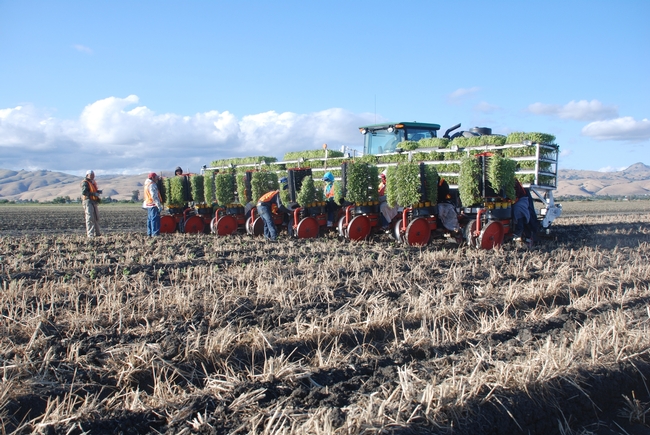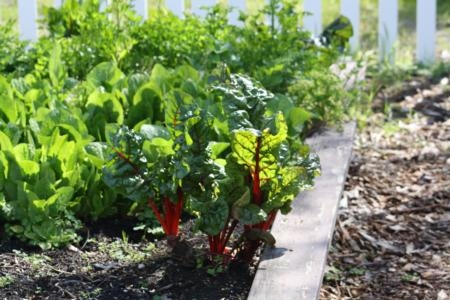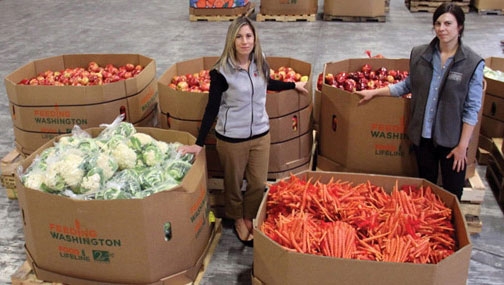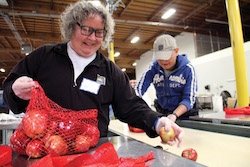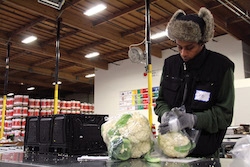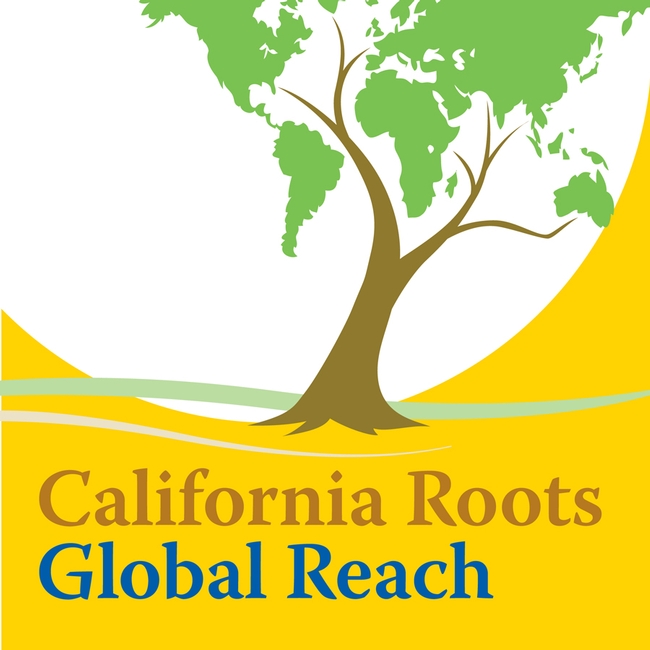Posts Tagged: hunger
Fighting hunger and building planet health go hand in hand
University leaders, faculty and students from across the U.S. and around the world are working together to tackle a complex set of challenges that prevent millions of people from getting enough of the right foods. In March 2021, UC Davis, the UC Global Food Initiative and the UC Agriculture and Natural Resources Nutrition Policy Institute, in partnership with the Hunger Solutions Institute at Auburn University, hosted a summit for members of Universities Fighting World Hunger, where more than 500 attendees from 22 countries sought solutions to the tragedy of world hunger, food insecurity and malnutrition that results in chronic diseases and obesity.
The 16th annual summit, held virtually for the second time, introduced a new way to address hunger by focusing on its connections to global climate change and the catastrophic COVID-19 pandemic.
Opening keynote speaker Bill Dietz, director of the Redstone Global Center for Prevention and Wellness at George Washington University, called the multiple threats to human well-being a “syndemic” driven by political power, capitalism, social norms and structural racism.
He suggested triple-duty solutions to the syndemic. For example, for U.S. populations, increasing plant-based foods and reducing beef consumption leads to (1) healthier diets that reduce obesity, diabetes and cancer; (2) improves nutritional quality and food security; and (3) lowers greenhouse gas emissions from agriculture and cattle production.
“I don't mean to say we eliminate beef,” Dietz said. “Beef can be healthy if grass fed and contains micronutrients. We need to reduce it. I don't pretend that's an easy lift. There is resistance at the highest levels of government. But we need to generate the political will to turn that around.”
Dietz recommended the development of local and regional food systems for food resilience, health, equity and environmental sustainability. Regional systems are more agile and not devoted to monoculture, such as that found in the U.S. Midwest where great swaths of land are managed exclusively for corn production.
“The question is not what we need to do, but how to do it,” Dietz said. “We need to act now. We need to build political will. We need to hold leaders accountable.”
A new Green Revolution
On the world stage, increasing access to food must address poverty, inequality, wars and politics, said Rattan Lal, distinguished professor of soil science at Ohio State University.
The projections that the earth will have 2 billion more residents by 2050 means there's a need for a new “Green Revolution,” Lal said. In the 1950s, fears that food production was lagging behind population growth were rampant. The fears were not realized due to the mid-century Green Revolution, in which research and technology boosted agricultural production worldwide with advances in variety selection, irrigation, synthetic fertilizers and pesticides. Yields rose exponentially.
“This miracle saved hundreds of millions from starvation,” Lal said. “Despite all that progress, there is still hunger.”
To meet food demand anticipated in 2050, the new Green Revolution must be different.
“Rather than input based, it must be natural resources based,” Lal said. “The strategy is to produce more food from less land, less water, less fertilizers and less energy.”
Managing agricultural land with regenerative principles – such as maintaining year-round soil cover, eliminating tillage and applying integrated nutrient management – leads to healthy, sustainable and productive soils that lock up carbon and minimize greenhouse gas emissions to the atmosphere.
“Something I hope to see protected in the new Farm Bill – the rights of soil,” Lal said. “Soil is a living entity. It has rights. We have a Clean Air Act, a Clean Water Act. It is time for a Healthy Soil Act. I hope it will be in 2022 or 2023. That involves policy translating science to action.”
The benefits of soil health are research-proven, but not yet widely implemented on farmland around the world, an example of a dichotomy shared by summit keynote speaker Jeffrey Sachs, an economist with the Center for Sustainable Development. He quoted the well-known observation of science fiction writer William Gibson, “The future is already here – it's just not evenly distributed.”
“There are solutions. I call them pathways. They are not gimmicks,” Sachs said. “Our work is to build the public understanding and awareness of the importance of these pathways.”
Sachs encouraged summit attendees to advocate locally and at the state and federal levels to promote new food systems approaches.
“Write blogs, op-eds and suggestions. What can corporations commit to? What should governments commit to? What can the food industry commit to?” Sachs said. “A lot of agricultural policies promoted by large commercial interests neglect environmental objectives. What we need is a one-world approach to move beyond the narrow view of a powerful corporate lobby and move to ecosystem sustainability in agriculture, carbon storage, healthful diets and a culture of appreciation of agriculture and healthful food.”
A role for land grant universities
Lorrene Ritchie, director of UC's Nutrition Policy Institute, said she believes UC Agriculture and Natural Resources and other land grant institutions can help direct humanity along a pathway of human and planet health.
“We have nutrition programs, dairy and beef research, irrigation, pest control, production, and natural resources expertise, and are well positioned to work together,” Ritchie said. “As a nutrition researcher, I can bring expertise on human dietary needs, while others can identify the crops that are most environmentally sustainable in different ecosystems. How we can get the best nutrition with the smallest environmental impact is the key question to address.”
Consumers can also help protect the planet's health with information to make educated decisions about their food choices.
“I would like to see food labeling not only for nutrition, but also on the product's sustainability,” she said.
Impacts from food on the planet's health involve production, water use, transportation, packaging and other factors.
“It kind of makes you dizzy to think about balancing impacts to human health and planet health. At UC ANR, we have the expertise and we can contribute to making progress in California and beyond in that regard. Complex problems will require multiple solutions – the time to act is now,” Ritchie said.
Urban farms can help feed the hungry
(The Sacramento Bee published an op-ed by Rachel Surls, UC ANR urban agriculture advisor for Cooperative Extension in Los Angeles County, in its editorial pages today. The op-ed is reprinted below.)
In similar discussions around the state on the desire of residents to raise their own food with fewer restrictions, there is a core issue that should be front and center. In California, where we grow half of the country's fruits and vegetables, our own citizens too often go hungry.
Fifteen percent of households – roughly 5.5 million Californians – are “food insecure,” according to a 2013 federal report, meaning they do not have “consistent access throughout the year to adequate food for healthy active living.” Families with children are even more likely to run short on food.
We know that eating plenty of fruits and vegetables is key to a healthy diet, but not everyone has ready access to a grocery store, or can afford to buy fresh produce. One potential solution is to make it easier to grow food in backyards and on vacant land.
The University of California's Global Food Initiative aims to help the world sustainably and nutritiously feed itself. One way that UC Agriculture and Natural Resources is working toward that goal is by providing information for urban farmers and decision-makers interested in urban agriculture to improve food security in their communities. While hunger and food security are complex issues, urban farming can be used with other strategies to help ensure access to affordable, nutritious food.
And the idea seems to resonate with Californians. Interest in urban food production can be seen around California. Following strong advocacy efforts at the grassroots level, Assembly Bill 551 was passed in 2013, allowing local governments to designate urban agriculture incentive zones. San Francisco has enacted the state's first one.
Several other cities have developed local policies to promote urban agriculture. San Diego, for example, has made it easier for residents to keep chickens and bees in their backyards, and to establish farmers markets, produce stands, community gardens and small urban farms. Oakland updated its city code in 2014 to allow community gardens in most of the city without a special permit.
But obstacles to urban agriculture remain in many cities, including land use restrictions, difficulty accessing water, soil contamination and a lack of information on local regulations. After conducting a statewide study, my colleagues and I found a number of common challenges and came up with six steps that local officials can take to break down common barriers.
They are: Make zoning and regulatory information accessible; develop a transparent process for using city-owned land; create an urban agriculture incentive zone; update zoning to make it urban-ag-friendly; make water accessible while promoting efficient use; and provide guidance and support for soil testing and remediation.
An easy way to let urban farmers know what is allowed is to post information on a website, as San Francisco has done. Through AB 551, cities can entice property owners to lease their land for gardens and farms in exchange for reduced property taxes. Cities can also partner with urban farmers and local food policy councils to identify concerns and ways to address them.
In addition to health benefits, urban gardens beautify the community and provide common ground for people of different ages and cultures to work together. They can also create jobs, learning opportunities and economic savings on food. Given the numerous potential benefits, local officials can better serve their communities by making it easier to cultivate food locally.
Banking on nutrition
It's a drizzly winter morning, and dozens of volunteers at the San Francisco–Marin Food Bank are slowly breaking down a 2,000-pound sack of whole oats into 1-pound bags, their hair tucked back in neat plastic caps. A decade ago, volunteers were more likely to be boxing up canned foods items. Today, 60 percent of everything ferried out of this warehouse is fresh produce. No soda or chips are in sight, and whole grains like these General Mills oats are standard.
For food banks nationwide to move in a similar healthy direction, coordinated efforts must increase at all levels. It will take leadership like that provided by Feeding America, the national food bank network organization; expanded support for nutrition policies at the local and regional levels; and donor efforts to supply more healthful foods. It's a tall order. But with the growing ranks of the food-insecure and obese, there is more pressure — and desire — than ever to provide low-income families with healthful food and create support for food bank nutrition policies to ensure that happens, says Patricia Crawford, UC Cooperative Extension specialist and director of UC Berkeley's Atkins Center for Weight and Health (CWH), a partnership between the College of Natural Resources and the School of Public Health.
“People managing food banks are taking charge and doing the difficult thing of modifying the healthfulness of the food donations they solicit,” says Karen Webb, a nutritional epidemiologist at CWH. “On the one hand, the food banks want an ample supply of foods to hand out, but they're also advocates for people in our most vulnerable population, so the nutritional quality of that food is important.”
There has been progress, which CWH researchers and their colleagues, at the request of the Institute of Medicine (IOM), the health arm of the National Academy of Sciences, have documented in ‘A Movement Toward Nutrition-Focused Food Banking,' an upcoming discussion paper to be released in summer 2014. The report details the evolution of food banking as the number of people served by these organizations jumped a whopping 46 percent from 2006 to 2010, according to Feeding America. Today, 12 percent of the population uses the emergency food system. Driven by increased demand, food banks have shifted from an emergency lifeline to a service filling a chronic need.
While organizations move to provide more healthful food, it's clear that pantry users, or clients, want these foods. A 2011 CWH study asked clients to rank calorie-dense snack-type foods and beverages as well as healthy options by order of preference.
“Food pantry clients ranked the most nutritious foods highest,” says Webb, a co-author of the IOM report. “Those foods are expensive, and they want to receive them. Meat, dairy, and fresh produce are at the top of their list, while soda and candy rank lowest.”
What policy looks like
Getting healthier food into clients' hands requires changes in both policy and practice, but what exactly is a nutrition-driven food policy? Many stakeholders are trying to effect change — food banks and the umbrella groups that support them, organizations and corporations that donate, and state and federal governments — but there are few cohesive policies and common standards to govern how they work together.
To start with, food banks can benefit from formal written guidelines that address the nutritional quality of the foods and beverages that they purchase or acquire from donations, according to the recommendations in the IOM report, whose authors include CWH's Elizabeth Campbell and Michelle Ross, Heather Hudson of the Food Bank of Central New York, and Ken Hecht, formerly with California Food Policy Advocates. A policy should guide the nutritional quality of the food bank's inventory as well as provide data analysis to track how successful the food bank is at distributing foods like produce and limiting unhealthful ones such as processed crackers and chips. Some 56 out of 200 food banks have a policy in place, according to a recent Feeding America survey, but more must be done.
Alameda County Community Food Bank (ACCFB) is a policy model, Crawford says. It established a written policy in June 2013, with the help of the nonprofit anti-hunger group MAZON and CWH. The project, which included several other food banks, was funded by Kaiser Permanente.
“We held focus groups with staff members and agency representatives,” says Jenny Lowe, ACCFB's nutrition education manager. “We wanted to get everyone on the same page. We asked, what are our practices? We'd been following this for a long time, but never wrote it down.”
The food bank's policy is now clear. They purchase fresh fruits and vegetables, low-sugar canned fruits, low-salt canned vegetables, low-fat milk, lean proteins, nut butters, beans, whole grains, packaged meals and soup.
To track the healthfulness of food, they use a computer system that ranks inventory by nutritional level (1, 2, or 3) and employ “traffic light” labeling on the warehouse floor and on order forms. Green is “choose frequently,” yellow “moderately,” and red “sparingly.”
“Green” foods are now more readily available at food banks across California because of the California Association of Food Banks' (CAFB) Farm to Family program, which connects state growers and packers to food banks. In 2011, CAFB, a nonprofit, membership-based umbrella group, sponsored AB152, now a state law, which enables farmers to get a 10 percent tax break on the inventory costs of fruits and vegetables they donate.
CAFB exemplifies how agriculture, advocates, and food banks can work together to create policies that incentivize the support system for healthy diets. Since 2005, the group has increased food bank produce donations by 92 million pounds of fruits and vegetables that might have otherwise been plowed under in the fields. “In California, we have a progressive agricultural community as well as progressive food bank organizers,” Crawford says. “It's that convergence that has made California a model and brought national attention to what we're doing.”
Other positive steps: Feeding America appointed a director of nutrition in 2011, and in 2012, it implemented Foods to Encourage, nutrition guidelines for promoting health—the food bank network's first-time effort at national guidelines. It's also running a pilot program that connects food-insecure clients who have Type 2 diabetes with nutrition, health education, and medical care.
Even with successes like these, there's still a long way to go.
Fresh food, new challenges
Six California food banks participated in a 2010–11 CWH study on inventory trends, funded by the Robert Woods Johnson Foundation. All six had significantly increased the amount of produce they provide to pantries, the study found, but hardy onions and potatoes made up about half of those gains. While the increase in fresh produce was dramatic, getting a variety of vitamins and minerals from different types of produce is key to good nutrition, Webb says.
“Food banks now must tackle the next challenge: adding more colorful yet hardy vegetables, such as bell peppers and broccoli," Webb said.
Part of that challenge is providing better distribution systems to pantries. Many food banks boast state-of-the-art facilities with refrigerated trucks and big walk-in refrigerators, but the pantries they serve are often basement kitchens and church halls with little access to refrigeration or storage. Policy changes must consider how to improve these conditions. For example, ACCFB provides farmers-market style distribution in parking lots to some clients, and both ACCFB and the state of New York help provide pantries with equipment grants to improve facilities.
Sourcing is another hurdle. Although emergency food clients strongly prefer low-fat dairy, lean proteins, and whole grains over soda and other less nutritious foods, it can be difficult for food banks to procure donations that align with these preferences and with nutritional quality guidelines. In 2013, 66 percent of donated foods came from big companies and represented the largest source for food banks, according to Feeding America. Donations of sugary beverages and snack foods have declined substantially, but have not disappeared from the shelves of the six California food banks in the CWH study. In 2010, one California food bank alone distributed over a million pounds—208 million calories—of what Crawford calls “liquid sugar” drinks. “That's a heck of a lot of excess calories going out to the most vulnerable people, who have a greater likelihood to be diabetic and overweight than higher-income folks,” Webb says.
Crawford notes that both the Central New York and Alameda County food banks have successfully implemented nutrition policies without offending donors or losing support.
Moving nutrition forward
In February 2012, anti-hunger leaders convened in Oakland, Calif., to discuss their findings from the 2010–11 Robert Wood Johnson Foundation study. There, CWH and California Food Policy Advocates called for food bank procurement policies that meet or exceed the Foods to Encourage guidelines, which were due to be released later that year.
In the most recent nudge forward, the IOM report recommends that items available through U.S. Department of Agriculture food distribution programs align with key recommendations from the 2010 Dietary Guidelines for Americans. Most food that the USDA supplies to food banks is already healthy, a recent study showed, and the agency is moving quickly to further improve nutritional quality by adding items like whole-grain pastas and brown rice. The report also recommends that food banks and advocates work with donors to find new ways to incentivize nutritious donations.
The IOM report represents a formidable increase in visibility for the issue of food bank nutrition, and Crawford wants to take advantage of the momentum. She's calling for a meeting of key stakeholders to discuss how to keep improvements to the emergency food system's nutritional quality moving forward.
Obesity and diabetes risk continue to plague the nation's health, and food banks will face big challenges in the coming year, including an expected rise in the number of clients as a result of the recent $8.6 billion in cuts to the Supplemental Nutrition Assistance Program — or SNAP, formerly known as food stamps — part of the farm bill passed in February, and as a consequence of California's drought, which is expected to bump up food prices.
“Those of us working in the field of hunger and food insecurity want the best for the people we serve,” Crawford says. “There is a moral imperative to do more than to provide just calories. We must provide foods that will help protect the health of the most vulnerable in our society.”
This article originally appeared in the spring 2014 issue of Breakthroughs, the magazine of the UC Berkeley College of Natural Resources.
World Food Center at UC Davis will tackle global issues
When you think casually of “food,” you may think of your next meal or your favorite food. “World food” may broaden your thinking to include international cuisines, global hunger, or a growing population. But the academic fields related to food are numerous. Food is one of life’s basic necessities, and along with its associated issues it is essential to the health and well-being of everyone, whatever their locale, education, or income level.
The new World Food Center at UC Davis will take on a broad purview related to food, including sustainable agricultural and environmental practices, food security and safety, hunger, poverty reduction through improved incomes, health and nutrition, population growth, new foods, genomics, food distribution systems, food waste, intellectual property distribution related to food, economic development and new technologies and policies.
With rapid global population growth occurring on smaller amounts of arable land, coupled with the expected impacts of climate change on food production, understanding the sustainability of food into the future is critical.
The new center’s website notes, “The World Food Center at UC Davis takes a ‘big picture’ approach to sustainably solving humanity’s most pressing problems in food and health. By bringing together world-class scientists with innovators, philanthropists and industry and public leaders, the center will generate the kind of visionary knowledge and practical policy solutions that will feed and nurture people for decades to come.”
In establishing the World Food Center, UC Davis Chancellor Linda Katehi said, “We did this to fully capitalize on our depth and expertise as the world’s leading university for education, research and scholarship on all aspects of food, but especially the nexus between food and health.”
UC Davis is the top-ranked agricultural university in the world, and California is the major producer of vegetables and fruit in the nation. Tom Tomich, director of the Agricultural Sustainability Institute and professor in the Department of Environmental Science and Policy at UC Davis, says of the World Food Center’s location at UC Davis, “There’s no place else that has the right mix of educational programs, research facilities, and the engagement with the state.”
The major academic disciplines surrounding food are found at UC Davis — agriculture, the environment, medicine, veterinary medicine, engineering, social and cultural sciences, and management. More than 30 centers and institutes at UC Davis will be pulled together through the World Food Center. The combination of scholarship, leadership, and partnerships at UC Davis has already established the campus as a center for food-related science and outreach. This new center will reinforce that strength and broaden the university’s ability to tackle tough global issues related to food.
Although the founding director of the center has yet to be named, Josette Lewis, Ph.D., was recently appointed as the associate director of the World Food Center. Her background on international research and development for the U.S. Agency for International Development, and director of its Office of Agriculture, honed her skills to take on the World Food Center. It was at US AID that she worked on a major global hunger and food security initiative, establishing her expertise on issues related to global agricultural development and food security.
As the new World Food Center becomes fully developed, it will be well-positioned on campus to continue to solve the major global issues related to food that are a hallmark of UC Davis.
Additional information:
- World Food Center website
- UC Davis video on the World Food Center
- Key facts
- UC Davis Dateline article
- Sacramento Bee article
UC Global Food Systems Forum to address challenges of feeding the world
The University of California, through its Division of Agriculture and Natural Resources, will convene some of the world’s leading experts April 9 at the Global Food Systems Forum to address how to sustainably feed 8 billion people by 2025. The discussion will bring together people from a dynamic range of disciplines, including farmers, researchers, policymakers, economists, environmentalists and geopolitical experts. The general public can view the event live by webcast.
The daylong forum, part of ANR’s Statewide Conference in Ontario, Calif., will feature two moderated panels and keynote addresses by Mary Robinson, former president of Ireland and president of the Mary Robinson Foundation – Climate Justice, and Wes Jackson, founder and president of The Land Institute.
Michael Specter, global issues writer for The New Yorker magazine, will moderate the first panel, which will focus on the geopolitical, ethical, economic, environmental and technical challenges facing food systems from a global perspective. Award-winning author and journalist Mark Arax will moderate the second panel, which will address the implications, responsibilities and innovative opportunities from a California perspective.
The panelists will include a mix of UC and non-UC experts and thought leaders. View a list of speakers at http://food2025.ucanr.edu/Speakers.
“As a public research university, we’re a recognized leader in tackling the world’s toughest challenges,” said Barbara Allen-Diaz, UC vice president for agriculture and natural resources. “Building on our expertise in agriculture and finding practical, science-based solutions, it falls to us to convene these sorts of conversations and look far beyond the borders of our campuses. Only through discussions of this nature will people find the common ground to move the world forward on what is a compelling, complex and crucial issue.”
The general public is encouraged to view the live webcast and join the conversation on Twitter by following (hashtag)Food2025. To learn more about the UC Global Food Systems Forum and to sign up to view the webcast, visit http://food2025.ucanr.edu.
Food forum at a glance
- WHAT: Live webcast of UC Global Food Systems Forum at http://food2025.ucanr.edu
- WHO: World-renowned leaders in food systems dialogue. See a list at http://food2025.ucanr.edu/Speakers
- WHEN: April 9, 2013 (9 a.m.-5 p.m. PDT)
- WHERE: Register for the webcast at http://food2025.ucanr.edu/Webinar


